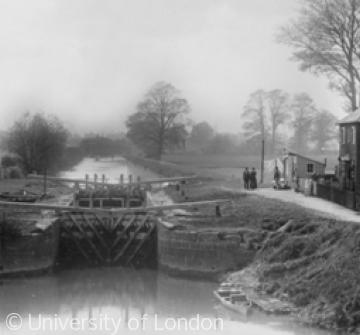Locks and Canals

Image: Culham Lock in 1888, a modern-style poundlock with gates at each end. The original Culham Lock (built 1624-36) stood further upstream towards Abingdon, and was one of the first three poundlocks on the Thames. (Oxfordshire County Council Photographic Archive, HT3888)
The earliest locks on the Thames were flashlocks, which had no gates for lowering the water level gradually. Instead, barges travelling downstream were carried through on the 'flash' or cascade of white water released when the weir was opened, which could be a dangerous business. Vessels travelling upstream had to be dragged up through the lock by cables and poling. In England the earliest modern-style poundlocks (with gates at each end) were built on the Exeter Canal in the 1560s, and on the River Lea in the 1570s. The earliest on the Thames were at Iffley, Sandford and Culham, built by the Oxford-Burcot Commission in the early 17th century. Their construction formed part of a major engineering project, which re-opened the river for commercial traffic as far upstream as Oxford (read more). Until then, heavy barge traffic had rarely penetrated much beyond Henley since the Middle Ages. Elsewhere on the Thames, the old flashlocks continued until belated improvements by the Thames Commission from the 1770s. The very last flashlock on the Thames (at Eaton weir) was removed in 1937. Improvements on the river in the late 18th century were accompanied by a 'canal mania' which in many ways prefigured the 'railway mania' of the 1830s-40s. Water transport was still the cheapest and most efficient way of transporting heavy bulk goods, and reputations and fortunes were gambled in promoting new artificial cuts to link emerging industrial areas with London and other markets. One of the largest was the Thames and Severn Canal (opened 1789), which created a continuous waterway from London to the Severn estuary.
But not everyone stood to gain from new canals. Canalisation of the River Kennett in the early 18th century turned Newbury into an inland port, but threatened the Thames trade through Reading, whose inhabitants responded by smashing engineering works and issuing death threats. Fifty years later Henley's role as an inland port was threatened by a proposed canal from Reading or Sonning to below Maidenhead, which would have bypassed the town. The scheme was defeated through the opposition of tradesmen and landowners from near Henley, Marlow and Maidenhead.
Similar battles between canal companies, riverside landowners and the Thames Commissioners rumbled on into the 19th century, fought through a series of polemical and often abusive pamphlets. Those involved included the Henley lawyer Zachary Allnutt, who as a Henley resident and Thames Commission officer had a double reason for opposing canals.
Read more about the Thames River trade or Henley's bargemen.
Content generated during research for the paperback book 'Henley-on-Thames: Town, Trade and River' (ISBN 13 : 978-1-86077-554-3) for the England's Past for Everyone series






